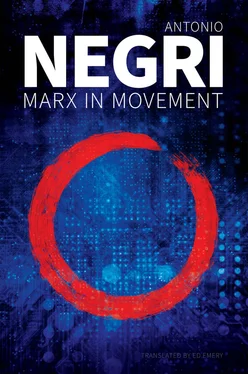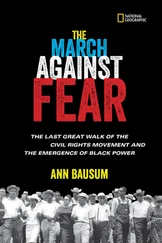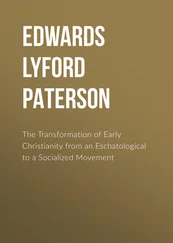One might well ask for a definition of this spontaneity of the struggles. For, while it is true that the struggles were in large part independent of the control and the command of the trade unions (and the unions were sometimes not even aware of them), at the same time they appeared – and were – strongly structured. They revealed the existence of new working-class leaderships that were, as we used to say, ‘invisible’ – in part because many people simply didn’t want to see them, but also (and mainly) because of their mass character, because of the new mechanisms of cooperation that were coming into play in the formation of workers’ political understanding, because of the extraordinary ability to circulate of these new forms of struggle, and because of the degree of understanding (of the productive process) that they revealed. And, while these new forms of struggle were at first seen by most people as ‘irrational’, in the course of their development they gradually began to reveal a coherent project and a tactical intelligence that finally began to problematize the very concept of working-class rationality. Economic rationality? Socialist rationality? Rationality of the law of value? Rationality of trade union control? Rationality of law and order? And so on. In effect, in the form taken by these struggles we could identify elements that were directly contradictory to the whole structure of trade unionist–socialist ideology. The wage demands, and the extremes to which they went, contradicted the way in which, in traditional trade union practice, the wage had been used as a political instrument, as a means of mediation. The partisan nature (egotism) of the struggles ran heavily counter to the socialist ideology of the homogeneity of working-class interests that had prevailed up until then. The immediacy and the autonomous nature of struggles ranging from wildcat strikes to mass sabotage, their powerful negative effect on the structures of the cycle of production, ran counter to the traditional view that fixed capital is sacrosanct, and also counter to the ideology of liberation of (through) work – in which work was the subject of liberation, and Stakhanovism or high levels of professional skill the form of liberation. Finally, the intensification (whether at group or at individual level) of heightened forms of mobility, of absenteeism, of socialization of the struggle, ran immediately counter to any factory-centred conception of working-class interests of the kind that has come down to us from the workers’ councilist tradition. All this gradually uncovered, in increasingly socialized forms, an attitude of struggle against work, a desire for liberation from work – whether it be work in the big factory, with all its qualities of alienation, or work in general, as conceded to the capitalist in exchange for a wage.
The paradox of the situation was that this mass spontaneity, highly structured in itself, negated in principle the very definition of spontaneity. Traditionally, spontaneity has been taken to mean a low level of working-class consciousness, a reduction of the working class to simple labour power. Here, though, it was different. This spontaneity represented a very high level of class maturity. It was a spontaneous negation of the nature of the working class as labour power. This tendency was clearly present, and later developments were to reveal it still further. Thus anybody who wanted to analyse the new forms of struggle was going to have to be prepared to problematize the entire theoretical tradition of socialism. Within these struggles there were new categories waiting to be discovered.
And this is what was done. In the early 1960s, on the fringes of the official labour movement, a number of working-class vanguards and a number of groups of intellectuals active within the class struggle produced a theory in which the mass worker was understood as the new subject of working-class struggles.
On the one hand, their studies identified the objective characteristics of this class protagonist. These characteristics were determined as follows:
within the organization of the labour process, by Taylorism;
within the organization of the working day and of wage relations, by Fordism;
within economic–political relations, by Keynesianism;
within general social and state relations, by the model and the practice of the planner state.
On the other hand, they succeeded in defining (this was absolutely imperative) the new subjective characteristics of this new configuration of the class. These subjective characteristics were described in terms that were dynamic and highly productive. In other words, every aspect of the capitalist organization of the factory society was to be seen as the product of a dialectic between working-class struggle and capitalist development (including developments in technology, in the form of the wage, in economic policy, and in the form of the state) – the product of a dialectic whose active and motive central force was the mass worker.
As our old friend Marx says, machines rush to where there are strikes.
All the mechanisms of capitalist control of development were brought to bear at critical points within the system. By means of a continual theft of the information generated by the struggles, capital created increasingly complex mechanisms of domination. It was within this framework that the analysis undertaken by workerism unstitched the capitalist Moloch, following the indications provided by working-class struggle. The comrades arrived at a fundamental theoretical conclusion: that, given a certain level of capitalist development, the concept of labour power (understood as an element of the dialectical relationship between workers and capital, a relationship in which capitalist logic has the upper hand) becomes dissolved. A dialectical relationship most certainly remains, but now the relationship between capital and labour power becomes the relationship of capital with the working class. Thus the dialectic of capitalist development is dominated by the relationship with the working class. The working class now constituted an independent polarity within capitalist development. Capitalist development was now dependent on the political variable of working-class behaviours. The concept of labour power could no longer be substantiated; only that of working class was adequate.
I have to admit that our theoretical and political positions in this period, while very rich in some respects, were very poor in others. Their richness lay in the fact that they provided a basis from which we could then develop an entirely political concept of labour power. We learned a lot from developments in the capitalist revolution of the 1930s and 1940s. In particular, we learned that it was possible to carry forward revolutionary struggles that had a marked effect both on the structure of the labour process and on the structure of economic and political domination – in other words, struggles that were capable of winning against Taylorism and within Keynesianism. On the other hand, the poverty of our theoretical and practical positions lay in the fact that, while individual struggles and the struggles of individual class sectors proved capable of understanding capital and taking it on, at the same time the potential of that struggle, its strategic dimension, and the re-establishment of a centre of revolutionary initiative remained beyond our grasp. Practice, even the highest working-class practice, at this level of the class struggle, always contains an element of uncertainty as regards its synthesis and resolution – what Lenin used to call ‘the art of insurrection’, an art that the workers today are seeking to turn into science. This science still had to be constructed – a science that the practice of the mass worker was demanding, but that it did not provide.
Читать дальше












